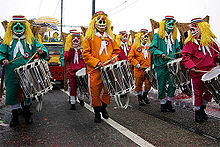Carnival clique
A carnival clique (often short clique , but also called carnival society) is a drum and whistler group that takes part in the Basel carnival . Carnival clique is on the one hand the music-making formation and on the other hand the entire club.
formation
The formation of the carnival clique consists of (from the tip to the end) vocal trab , pipers , drum major and tambours (drummers), whereby the exact order varies in part. The clique plays traditional carnival marches on these three days, disguised in imaginative costumes and larvae ( masks ) on their drums and piccolos .
Advance
On the one hand, the Vorrab provides enough space on the march route, on the other hand it presents the subject (subject) of the clique with a prop mounted on wheels, an artistically painted lantern and distributes flyers, so-called Zeedel, on which satirical and often sarcastic verses are written in the Basel German dialect , which further describe the subject. Fewer and fewer pioneers are used in the advance who proudly run ahead on horseback. Sometimes you come across hobby horses or imitations made of wood and cardboard instead , so-called Junteressli .
game
Piper , drum major and drum make up the game . Depending on the size and tradition, the order of the three subgroups in the formation changes. The most common variants are P - TM - T and TM-TP. In addition, you often come across pure drum or piper groups. The instrument of the piper ( pfyffer ) is the piccolo . The tambours (also called drummers ) play on a Basel drum made of metal or wood.
repertoire
The repertoire is the list of marches that a carnival clique dominates and comprises an average of 35 pieces, which are played in rotation during the three days of carnival. There are both traditional and new marches that appear in the repertoire of the cliques. The most famous marches are called Morgestraich , Arabi and Alti Swiss marches .
society
Large carnival cliques (regular cliques) always consist of several formations that run at the carnival. The groups are usually separated by age and sometimes also by gender. Some cliques even prohibit membership of a gender in their statutes. Common groups are Binggis (children from approx. 8 years), Young Guard (young people 12–18 years), parent club (from 18 years) and Old Guard (for members who no longer want to run the brisk pace of the parent club). Many clubs train their offspring themselves in drum and whistle schools. Some cliques also offer adult courses.
At the Cortège , the individual departments of the regular cliques usually run alone, together with the whole clique they admit on Morgestraich and on Monday and Wednesday evenings (each for one or two tours).
In addition to the regular cliques, there is also a large number of smaller groups, the Pfeifer & Tambours groups, which run on the Cortège .
Well-known cliques
The oldest still existing carnival society is the VKB, the United Kleinbasler from 1884, based in Kleinbasel . The second oldest clique is the Breo clique 1896 from Grossbasel. According to the official carnival guide "Rädäbäng 2016", a total of 36 regular cliques, 40 old gardeners, 60 young gardeners & binggis, 65 pipers and drum groups, 120 carriages, 59 guggen music, 19 chaises, 53 groups and 10 individual masks are registered for the Basel Carnival 2016 .



